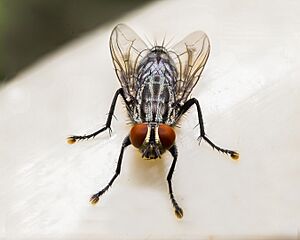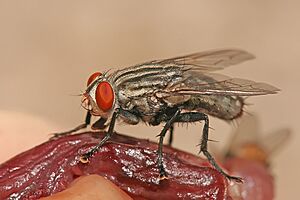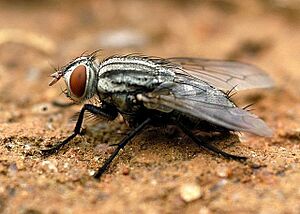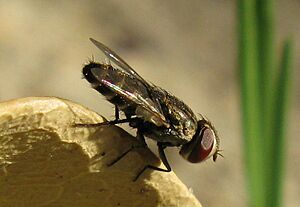Flesh fly facts for kids
Quick facts for kids Flesh flies |
|
|---|---|
 |
|
| Sarcophaga bercaea | |
| Scientific classification |
|
| Unrecognized taxon (fix): | Sarcophagidae |
| Subfamilies | |
|
|
Flesh flies are a group of flies known as Sarcophagidae. They get their name because they often lay their young on dead animals or decaying matter. Unlike most flies that lay eggs, flesh flies are special. They are ovoviviparous, which means they keep their eggs inside their bodies until they hatch. Then, they release tiny, hatched maggots (larvae) instead of eggs.
These maggots need protein to grow. So, the mother fly places them on things like dead animals, animal waste, or even open wounds on mammals. Adult flesh flies usually drink fluids from dead animals, nectar from flowers, or other sweet liquids. They also feed on animal waste and other organic stuff.
Contents
What Do Flesh Flies Look Like?
Flesh flies are usually small to large, about 0.4 to 2.3 centimeters (0.16 to 0.9 inches) long. Many of them have black and gray stripes running along their upper body (called the thorax). Their lower body (the abdomen) often has a checkered pattern.
You can usually spot a flesh fly by its red eyes and its bristly abdomen. Another cool feature is their antenna, which has a feathery part near the base.
Types of Flesh Flies
There are about 2500 different kinds of flesh flies! Scientists group them into three main subfamilies:
- Miltogramminae
- Paramacronychiinae
- Sarcophaginae
These subfamilies contain over 100 different genera (groups of similar species).
Flesh Fly Life and Habits
Different types of flesh flies have different habits:
Sarcophaginae: Scavengers and More
Most species in the large Sarcophaga group are scavengers. This means they eat dead things, like small dead insects, snails, or even larger dead animals. Sometimes, flesh fly maggots might even eat other smaller larvae if they get in the way. These flies and their maggots also eat decaying plants and animal waste. You might find them around compost piles or outdoor toilets.
Miltogramminae: Sneaky Eaters
Members of the Miltogramminae subfamily are known as kleptoparasites. This is a fancy word for "thieves." They steal food from other insects, especially solitary bees and solitary wasps. For example, a female flesh fly might lay her maggots in the nest of a solitary bee. The maggots then eat the food the bee collected for its own young.
Paramacronychiinae: Hunters and Scavengers
This subfamily includes flies with various eating habits. Some, like Agria, are predators or parasites of Lepidoptera (moths and butterflies). Others, like Brachicoma, hunt the young (especially pre-pupae) of bumblebees. Then there are general scavengers and insect hunters, such as Sarcophila and Wohlfahrtia.
Flesh Flies and Health
Flesh flies can sometimes carry tiny germs, like those linked to leprosy. They can also cause a condition called myiasis if their larvae are accidentally eaten by people. Myiasis means that fly maggots live inside a living animal or person.
Certain flesh flies, especially Wohlfahrtia magnifica, can cause myiasis in animals, particularly sheep. This can lead to infections or other health problems for the animals.
Identifying Flesh Flies
It can be tricky to tell different species of flesh flies apart. Usually, only male flesh flies can be reliably identified to their exact species. This is done by carefully looking at their reproductive parts under a microscope.
See also
- List of parasites of humans





